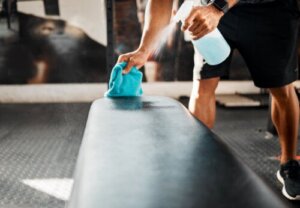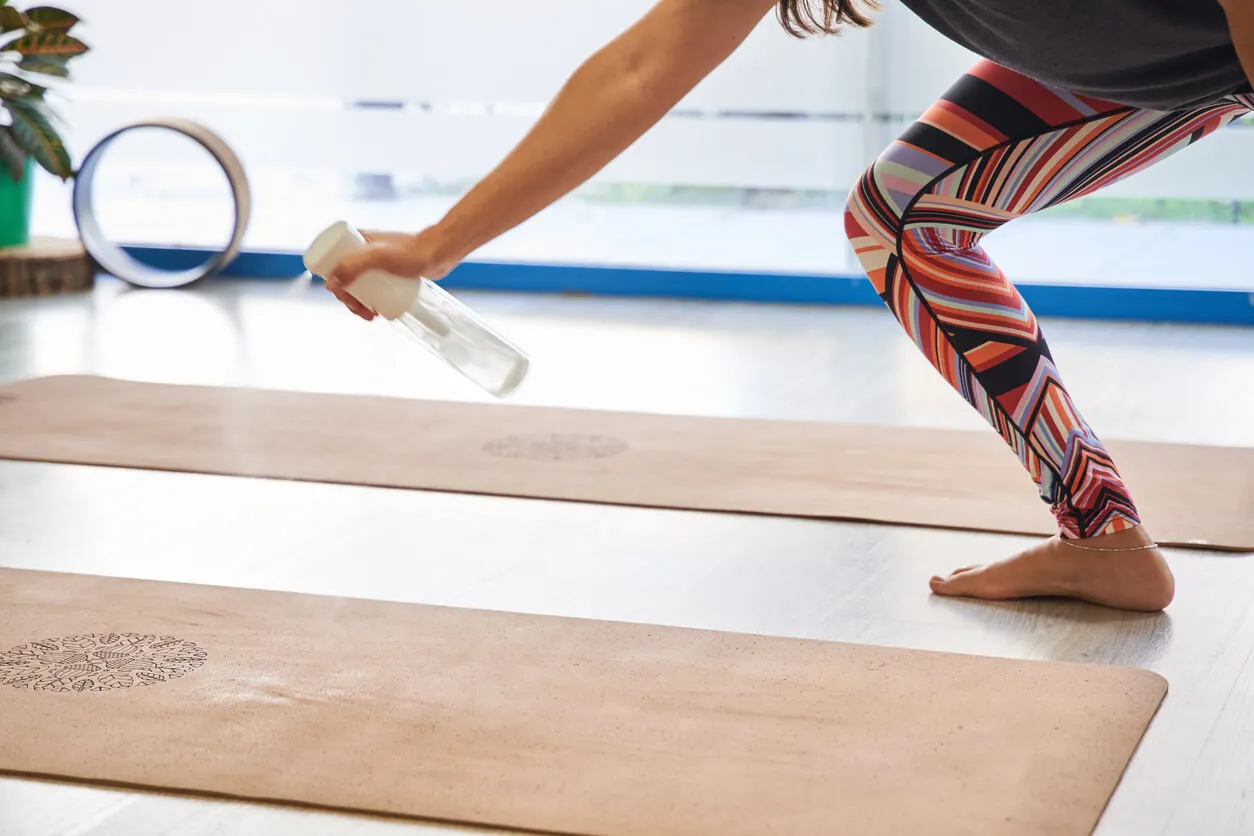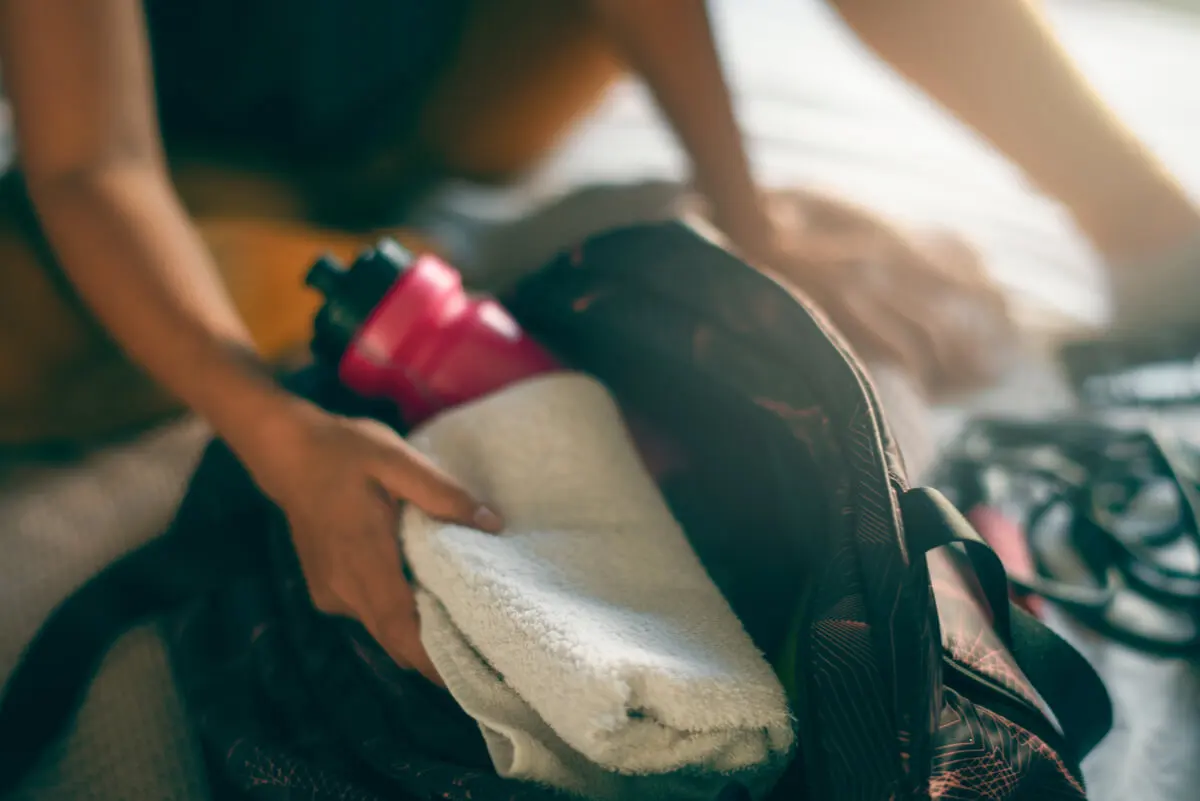10 Gym Hygiene Tips Everyone Should Follow


Reviewed and approved by the doctor Leonardo Biolatto
Gym hygiene habits are not only the responsibility of those in charge of maintaining the area and the machines. Those who come to train are responsible for their own cleanliness, personal implements, and the equipment they use.
Risks of contracting viruses, infections, and accidents are minimized if you follow hygiene tips such as the ones presented here. It’s time to take them into account for your routines!
What are the risks of improper gym hygiene?
In the gym, it’s very easy to catch respiratory diseases, if any of the attendees have one of these conditions. All it takes is a sneeze or not washing your hands for contamination to spread rapidly among the treadmills, weights, and other instruments.
Moreover, fungi and bacteria on the surfaces where you exercise are triggers of skin alterations. These germs also settle on towels, pool, and bathroom floors, increasing the likelihood of fungal infections.
Jock itch and staph infection are other consequences of poor hygiene in the gym. In addition, the University of Maryland School of Medicine adds COVID-19 and impetigo as possible diagnoses, whose origin could be the gym environment.
An inquiry by the International Journal of Environmental Research and Public Health reflects gyms and exercise facilities as possible sources of infection transmission. They even point out that there is a diversity of 25 bacterial genera of human and environmental origin, easy to contract in these sports halls.
Medical conditions due to staphylococci are the most common.
Essential tips for good hygiene at the gym
Good hygiene at the gym includes basic indications such as not touching your face, especially without washing your hands. Also, always keep your shirt on to avoid getting sweat drops on the equipment, and make sure to pick up the implements you carry with the purpose of not spreading or picking up germs. These are fundamental hygiene suggestions during any form of training.
It’s also worth considering the sanitation tips we’ll reveal below.
1. Bring your own equipment
Certain exercises require lying on the floor, resting your hands, and generally having friction with surfaces. For example, some yoga postures involve putting your face on the lining of a mat; bring your own so you don’t have any doubts about its cleanliness. The same goes for garters, towels, and girdles, among other implements.

2. Don’t drink from the drinking fountain
Do not drink from the communal water fountain for any reason. Athletes arrive there to hydrate themselves and it’s very likely that sweat drops are left in the faucet. The best thing to do is to have a personal water bottle so that you can carry the water and refill it when you need it.
3. Disinfecting equipment is part of good hygiene in the gym
Before the routines, clean the machines you will use with disinfectant towels and spray or a hydro-alcoholic gel. At the end of the circuit, do the same.
According to a review by Pediatrics, one of the greatest risk factors for contagion is the sharing of contaminated equipment, mainly when used by a patient with active skin infections.
4. Wash your hands
It’s always necessary to repeat this recommendation. The correct thing to do is to wash your hands before and after training, using soap and rubbing the palms and back of your hands for 20 seconds. Finally, rinse well.
It makes no difference whether you do it with hot or cold water. The important thing is to enter and leave the gym with clean hands.
5. Do not expose wounds
Just like skin infections, open wounds should not be exposed in the gym. The best thing to do is to cover them with waterproof bandages and avoid swimming pool sessions or whirlpool baths, as the bacteria will end up in the water.
In particular, sutured wounds are a relevant source of bacteria in swimming pools. In these cases, you should wait for the stitches to be removed or to fall out on their own, as this is a sign of healing.
Like this article? We think you may also like to read: Preventing Skin Infections at the Gym
6. Wear shoes or protective footwear in common areas
The Mayo Clinic says the risk of ringworm on the skin is elevated by walking barefoot in public areas where infection can spread:
- Saunas
- Swimming pools
- Locker rooms
- Common bathrooms and showers
To prevent this, wear protective footwear in the shower area and pool. When getting out of the water, wash your feet thoroughly and dry them meticulously between the toes. Additionally, you can sprinkle antifungal talcum powder, especially if you are prone to athlete’s foot.
7. Wash your gym clothes as soon as you take them off
Do not rewear sweaty clothes in a new workout. Gym clothes should be washed regularly and after every use. It happens that unpleasant odors last longer in elastic fabrics.
The American Academy of Dermatology suggests the use of loose-fitting, moisture-wicking clothing so that your skin remains dry and there is no growth of harmful germs. Likewise, they highlight the need to wash gym clothes after use.
8. Keep your personal care items sealed
Lending towels, toiletries, or thermoses is a channel for contamination. Make sure that all your sports equipment is always in the bag you use for this purpose. In case you catch someone else using your items, be sure to disinfect them.

9. Shower at the end of your routine
In an experiment in the journal Applied and Environmental Microbiology, 26 T-shirts were taken from participants in a spinning session; the garments were incubated for 28 days and then analyzed by a panel trained in odors. The results found that the fiber composition of the clothing promotes the differential growth of textile microbes and the generation of unpleasant odors.
Because of this, it’s advisable to take a shower before leaving the gym. This way, sweat on clothing doesn’t accumulate germs, doesn’t harm the skin, and, of course, doesn’t cause a stench.
Although it’s best to shower and change into fresh clothes soon, if you need to run another errand before you get home, at least disinfect your clothes by spraying a solution containing 60% alcohol. It’s also appropriate to pour a little disinfectant on your hands and rub them dry.
10. If you don’t feel well, don’t go to the gym
It’s a big mistake for sick people to train at the gym because they risk acquiring extra infections and risk infecting other people. Even if it’s just a cold, it’s best to stay home; any virus in the environment increases unhygienic conditions.
Even an upset stomach is a health hazard. In fact, Morbidity and Mortality Weekly Report exemplifies that the risk of pathogen transmission is increased if swimmers with diarrhea enter the pool without first washing the body or if a fecal incident occurs in the water.
We think you may also like to read this article: What’s the Best Food When Going to the Gym?
What you should remember about good hygiene at the gym
Make grooming before, during, and after your gym routines a habit.
Remember that your items are yours alone, that feeling sick is a sign to rest at home, and that washing sports clothes and personal implements are just as important as disinfecting commonly used equipment. The most important thing for good hygiene to prevail in the gym is to choose an establishment that complies with sanitary norms and that shows this in the quality of the environment and the state of the machines.
All cited sources were thoroughly reviewed by our team to ensure their quality, reliability, currency, and validity. The bibliography of this article was considered reliable and of academic or scientific accuracy.
- AAD. Cómo prevenir las infecciones comunes en la piel en el gimnasio. Asociación Americana de Dermatología. https://www.aad.org/public/everyday-care/skin-care-secrets/routine/prevent-skin-infections-at-the-gym
- Callewaert, C., De Maeseneire, E., Kerckhof, F. M., Verliefde, A., Van de Wiele, T., & Boon, N. (2014). Microbial odor profile of polyester and cotton clothes after a fitness session. Applied and environmental microbiology, 80(21), 6611–6619. https://doi.org/10.1128/AEM.01422-14
- Centers for Disease Control and Prevention (CDC) (2013). Microbes in pool filter backwash as evidence of the need for improved swimmer hygiene – metro-Atlanta, Georgia, 2012. MMWR. Morbidity and mortality weekly report, 62(19), 385–388. Estados Unidos. https://www.ncbi.nlm.nih.gov/pmc/articles/PMC4604905/
- Clínica Mayo. (2022). Pie de Atleta. Clínica Mayo. Estados Unidos. https://www.mayoclinic.org/es-es/diseases-conditions/athletes-foot/symptoms-causes/syc-20353841#:~:text=Complicaciones,las%20manos%20o%20las%20toallas
- Davies, HD., Jackson, MA., Rice, SG. (2017). Enfermedades Infecciosas asociadas al deporte organizado y control de brotes. Pediatrics, 140(4):e20172477. https://publications.aap.org/pediatrics/article/140/4/e20172477/38139/Infectious-Diseases-Associated-With-Organized
- Mukherjee, N., Dowd, S., Wise, A., Kedia, S., Vohra, V., & Banerjee, P. (2014). Diversity of Bacterial Communities of Fitness Center Surfaces in a U.S. Metropolitan Area. International Journal of Environmental Research and Public Health, 11(12), 12544–12561. https://doi.org/10.3390/ijerph111212544
- Universidad de Meryland. ¿Se puede contraer una infección por estafilococos en el gimnasio? Facultad de Medicina de la Universidad de Meryland. Estados Unidos. https://health.umms.org/2021/11/10/staph-infection-gym/
This text is provided for informational purposes only and does not replace consultation with a professional. If in doubt, consult your specialist.








